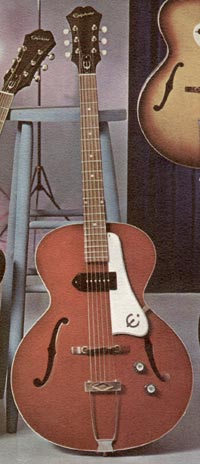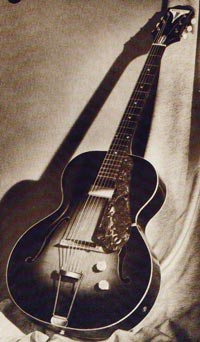
Epiphone Century main page | 1959 Epiphone Century | 1963 Epiphone Century

Epiphone Century - image taken from the 1966 Epiphone catalogue

Stathopoulos-era Epiphone Century - from the 1954 Epiphone catalogue
The Epiphone Century was manufactured by Epiphone from 1939, until the mid 1950s, under the ownership of the Stathopoulos family. It was a full body depth non-cutaway archtop with a Cherry wood neck and either Blonde or Shaded finish. It was a fairly basically appointed though one of their earliest electric models, with a single Epiphone New York pickup at the neck position.
After Epiphones aquisition by Gibson parent company CMI, in 1957, Century production continued; these Kalamazoo-built Gibson Epiphones are generally better known than the original version. They were similar though, sharing the same 16 3/8" x 20 1/4" body size - though the 'Gibson' version had a new 1 3/4" thinline body size. When Gibson bought the Epiphone brand, they also bought unfinished guitar parts, tooling and components. Many pre-aquisition Epiphone parts were fitted to early Kalamazoo-produced Epiphones. They shipped in moderate numbers between 1969 and 1969.
The Epiphone range of the late 1950s and 1960s closely followed the Gibson guitars of the same time; they were both made in the same fatory in Kalamazoo. The Century corresponds to the Gibson ES125T having the similar dimensions and construction, but with different headstock shape and a slightly longer scale (25 1/2" versus 24 3/4" for the ES125T).
From 1959-60/61, Century models often had the old Epiphone metal plate logo, tortoise-shell pickguard and often the New York humbuckers. Some early models also had pre-CMI Epiphone three-ply necks (and potentially pre-CMI tops or backs too). Examine a 1959 Epiphone Century.
Once all the pre-Gibson parts were used, the Century became less distinct from other guitars built at Kalamazoo, and naturally contained several Gibson trademarks; most notably the one-piece mahogany neck. The New York humbucker was replaced by a single coil P90 pickup, early catalogues suggesting white plastic covered units, mid-sixties catalogues showing black plastic.
A 3/4 size version of the Century was also available between 1961 and 1967, only available in Royal Burgundy finish, and only shipped in very small numbers.
Compare two versions of this guitar above: left, the 1959 Epiphone Century, with pre-Gibson era features old-style control knobs, New York pickup, tortoise-shell pickguard, metal headstock plate and three-piece neck (the Bigsby vibrato is not original) ; right: 1963 Century with mahogany neck, P90 pickup, bell-style control knobs, five ply white scratchplate and standard silk-screened headstock logo.
There was one significant extra change to the Century from late 1963/early 1964. The well-known Epiphone headstock shape was updated, widening at one end, with an exagerated open book top. Have a look at the image above from the 1966 catalogue.
| 1959 | 1960 | 1961 | 1962 | 1963 | 1964 | 1965 | 1966 | 1967 | 1968 | 1969 | total | |
| Epiphone Century E422T | 276 | 285 | 362 | 222 | 169 | 128 | 367 | 335 | 50 | 23 | 11 | 2228 |
| Epiphone Century E422T¾ | 37 | 16 | 12 | 4 | 29 | 2 | 18 | 118 |
$2495
$3335
£3500
£3250